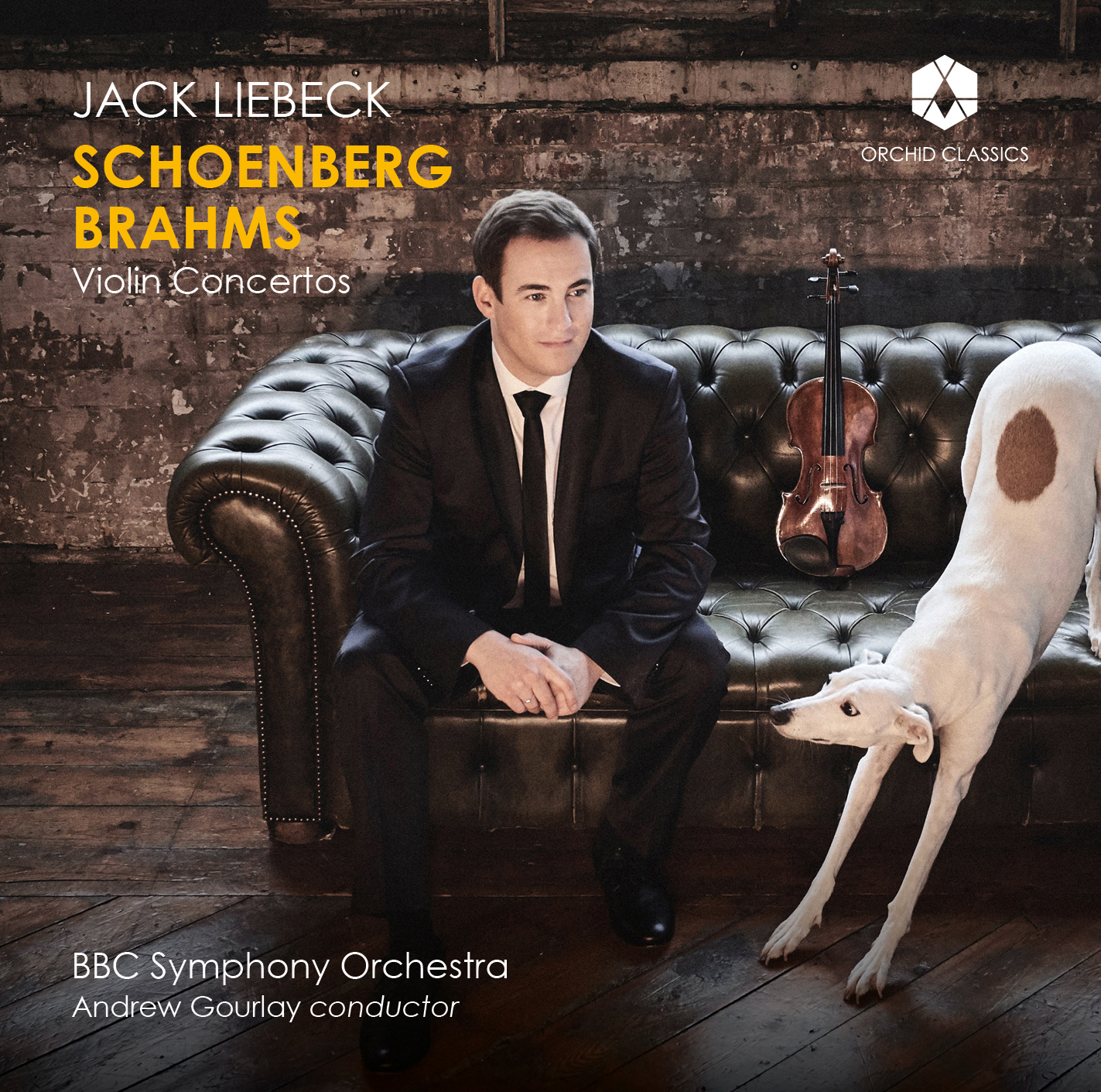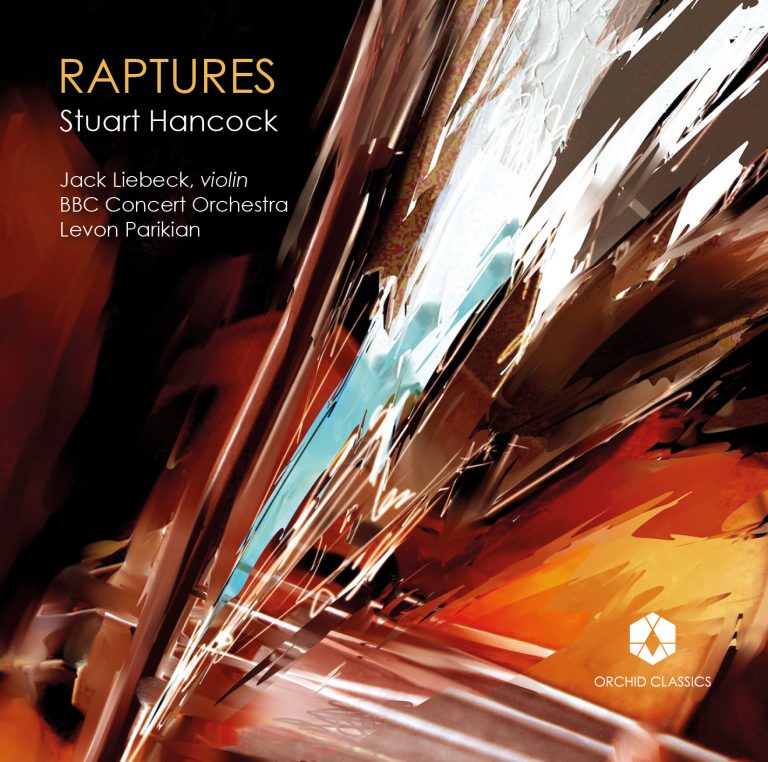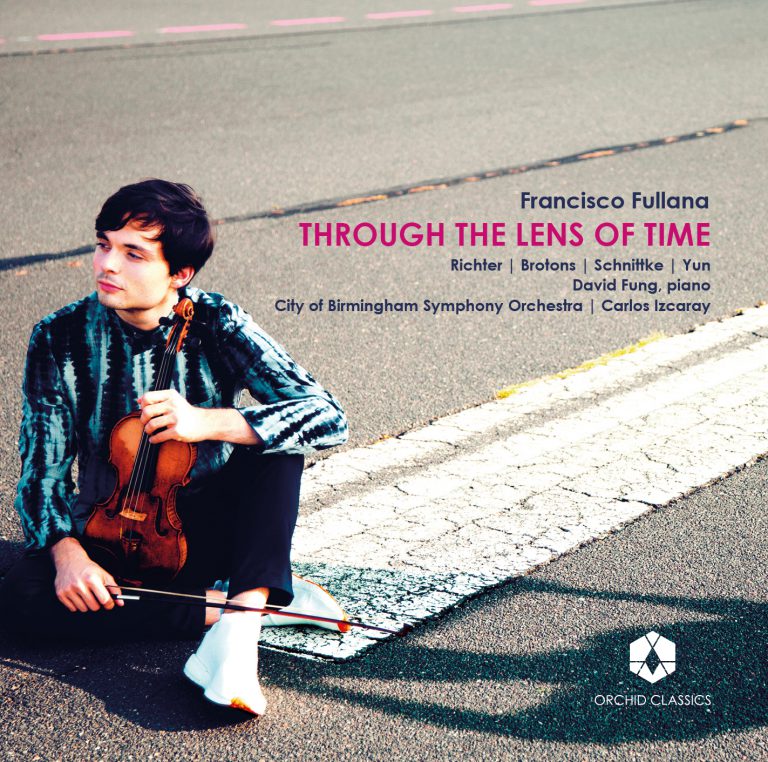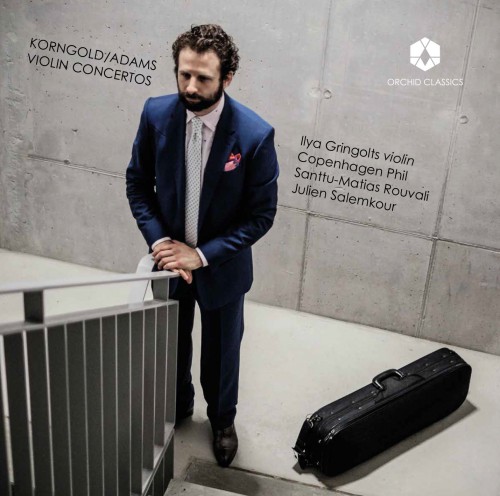Artist Led, Creatively Driven

Jack Liebeck
Schoenberg / Brahms
BBC Symphony Orchestra
Andrew Gourlay
Release Date: March 20th 2020
ORC100129
Arnold Schoenberg (1874 – 1951)
Violin Concerto, Op.36
1 Poco allegro – Vivace 14.00
2 Andante grazioso 8.35
3 Finale: Allegro 13.10
Johannes Brahms (1833 – 1897)
Violin Concerto in D, Op.77
4 Allegro non troppo (cadenza by Fritz Kreisler) 23.46
5 Adagio 9.09
6 Allegro giocoso, ma non troppovivace – Poco più presto 8.35
Total time 77.15
Jack Liebeck, violin
Andrew Gourlay, conductor
BBC Symphony Orchestra
In recent times, with the rise of the far-right and identity politics, I have been forced into a conversation with myself about my identity and belonging. Coming from a Jewish, German and Dutch family, my grandparents (survivors of the Holocaust), had to leave Europe looking for the safety of a new life in South Africa. In turn, my parents left South Africa in the early 1970′s looking for a more welcoming country in which to bring up children, and to get away from the state-run racism which afflicted the nation. There was no more cosmopolitan and ‘happening’ place than London and I feel truly blessed to have been able to make my life as a first generation Brit. I grew up in a country which was welcoming of all cultures, I never experienced racism growing up in the UK, it was truly a haven. However, in the current global climate of xenophobia and close-the-borders mentality, racism has raised its ugly head first-hand to me – I find myself suddenly forced to ask, where do I really belong?
In particular, I find myself reflecting on my grandfather, Walter Liebeck (1904 – 1987). He was an extremely accomplished violinist, also studying law atthe university in Konigsberg. In 1934 his university professor suggested he leave Germany for his own safety, following a request for the names of Jewish students from the government. Walter made a new life for himself in Cape Town, and unable to finish his law degree, became an insurance salesman. I often think about how the dreams and aspirations of a whole generation were crushed due to upheaval of the war and consider how lucky I have been, through the lottery of life, to follow my talent and dreams without interference from external forces. I feel my grandfather’s presence more and more as I get older; he never heard me play, I started playing after he passed away, yet somehow I can feel him there in myplaying.
My grandfather always spoke about Brahms’ Violin Concerto as the greatest of the violin repertoire and ever since I was a child, I have also felt a great affinity for Brahms’ music. The sound-world he created and the utter beauty and musical intensity of his writing were deeply human, expressing emotions from elation to despair, juxtaposed against the seemingly titanic planetary forces of the orchestra. Brahms’ concerto is one of the pinnacles of the violin repertoire and, as I enter my 40th year, now seems to be the moment to record my grandfather’s favourite violin concerto with him in my mind.
In the search for a suitable companion to the Brahms, I decided to look for something that would complement the Brahms, but also put into some context my reason for entering the studio and my family’s journey. I decided to focus on the seldom performed or recorded Schoenberg Violin Concerto (1934 – 36). Schoenberg, similarly forced from Germany into exile in California a year before my grandfather’s settlement in Cape Town, wrote the Violin Concerto shortly after his arrival. Musically, the concerto seems to follow naturally on from the idiom of the Brahms despite utilising the twelve-tone technique as its harmonic basis. There is a troubled passion, depth and darkness throughout much of the concerto, its harshness and great beauty mingle in an incredible dialogue between violin and orchestra. Very few composers were able to achieve this from serial composition, Schoenberg being one of the few masters. One can feel the turbulent atmosphere of the 1930s distilled into the music.
I’m thrilled that I’m able to record this with such an incredible orchestra, conductor and producers.
Jack Liebeck, 2019
Brahms has sometimes been perceived as rather reactionary; a composer deeply influenced by precedent and desirous of continuing the tradition he had inherited from the likes of Beethoven and Robert Schumann. Yet he found an unlikely advocate in Arnold Schoenberg, who wrote a provocative essay in 1933 entitled, ‘Brahms the Progressive’. Instead of taking the fashionable view that Wagner was the 19th century source from which 20th-century innovation sprang, Schoenberg allied himself with a composer regarded by many as the polar opposite. For Schoenberg, Brahms knitted together his ideas with such coherence that he paved the way for the twelve-tone methods of the Second Viennese School, consisting of Schoenberg himself and his students, Berg and Webern. It was also in 1933 that Schoenberg moved from Germany to the USA to escape the increasing threat of Nazi oppression. In 1934, he moved from the east coast of America to Los Angeles, in pursuit of the health benefits of a warmer climate, and taking a job at the University of California, Los Angeles, where he is described as turning up for classes in elaborate outfits: “… a peach-colored shirt, a green tie with white polka-dots, a knit belt of the most vivid purple with a large and ostentatious gold buckle, and an unbelievably loud gray suit with lots of black and brown stripes.”
The move coincided with what Schoenberg called an“upsurge of desire for tonality”. He had pioneered his revolutionary serial techniques in the 1920s (using strict ‘rows’ in which every pitch is allowed once without repetition), but produced a number of essentially tonal works in the 1930s. The Violin Concerto, Op.36, is a twelve-tone work in a neoclassical style, composed in the hope that it would be marketable – popularised by virtuosos via the increasingly influential medium of radio broadcasts.
Schoenberg had started working on the Violin Concerto by the summer of 1935 and completed it on 23 September 1936. It was his first twelve-tone work since his opera, Moses und Aron (1932). In 1937 Schoenberg described the concerto as: “extremely difficult, just as much for the head as for the hands. I am delighted to add another ‘unplayable’ work to the repertoire. I want the concerto to be difficult and I want the little finger to become longer. I can wait.”
Schoenberg’s Violin Concerto was premiered on 6 December 1940 by Louis Krasner, who had also premiered Berg’s Violin Concerto, with the Philadelphia Orchestra under Leopold Stokowski. In the fascinating opening movement both serial and neoclassical devices are to the fore: the ‘row’ is explicitly articulated, framed by a structure founded on the Baroque ‘ritornello’ principle in which solo and ensemble sections alternate. The work opens with the soloist, and the first orchestral section is layered gradually to create a surge of sound. On the soloist’s return, the orchestral texture features pizzicato strings and sustained writing for the woodwinds. The soloist plays fiendishly challenging double and triple-stopped harmonics – one of the reasons the work has become notorious – and the orchestra ushers in a section marked Vivace. The cadenza is full of widely-spaced leaps and harmonics, and the movement closes with the violinist reprising its opening material. The orchestra becomes more prominent in the exquisitely crafted Andante grazioso, with the violin only reclaiming its dominance later in the movement. At the very end, the soloist reiterates its opening idea at a lower pitch before trailing off mid-way through the phrase.
The marching finale begins with the soloist playing the main theme before the orchestra takes over, unfurling a rich array of ideas including colourful percussion. The violin regains control, exploring extreme registers. Towards the work’s end, the violin spits out its last outbursts, answered by final surges from the orchestra before the work’s flame is abruptly extinguished.
Brahms wrote his Violin Concerto in D, Op.77, for and in collaboration with his friend, the celebrated violinist Joseph Joachim. When he had heard Joachim playing the Beethoven Violin Concerto with the Hamburg orchestra in 1848, Brahms was deeply impressed. Thirty years later, in August 1878, he wrote to Joachim, telling him to expect “a few violin passages”. This turned out to be something of an understatement: Joachim was presented with the vast violin part of what would become the concerto’s first movement. Brahms conceived the work on a symphonic scale, originally planninga four-movement concerto, and although the piece ended up in the more conventional three-movement structure, its character and orchestration retain a symphonic spaciousness and gravitas.
Joachim was a composer as well as violinist, and his priority in helping Brahms was to make the Violin Concerto as idiomatic as possible for the soloist. Brahms easily lost patience with the details of fingerings and bowings that are often an essential guide for the violinist; when he later collaborated with Joachim on a Double Concerto, Brahms declared: “Oh, how much more agreeable and sensible it is to write for an instrument one knows thoroughly – as I presume to know the piano.”
Despite these technical hitches, work on the Violin Concerto progressed steadily, with Brahms posting Joachim chunks of the violin part at regular intervals. The two also met up frequently, on which occasions Joachim would play and rewrite passages, often introducing virtuosic elements into the music. Brahms accepted some of these suggestions and rejected others; or he would think up a third option based on Joachim’s input.
Joachim was not afraid to give Brahms unvarnished criticism of his music, but he was also patient: Brahms veered between demanding stricter advice from Joachim, and ignoring the ideas offered. Although he was exasperated by this inconsistency, Joachim’s resilience stemmed in part from his wish to perform what he hoped would turn out to be a dazzling work. He pressured Brahms to have the concerto ready for performance at a New Year’s Day 1879 Concert in Leipzig. Brahms, meanwhile, admitted that had been forced to discard the four-movement scheme: “The middle movements are bust – naturally they were the best ones! I’m writing a wretched adagio instead.” The two movements that did not fit into the concerto were used elsewhere, one of them in the Second Piano Concerto. Brahms seems to have been feeling the pressure towards the end of 1878, writing a vehement letter to his publisher, Simrock: “Done! What is done? The violin concerto! No.”
Even the concerto’s final manuscript includes many revisions to the violin part, some of them written in by Joachim, whose hard work was rewarded when Brahms gave him free rein to composethe first movement’s cadenza. Joachim argued that: “The Germans have four violin concertos. The greatest, most uncompromising is Beethoven’s. The one by Brahms vies with it in seriousness.”
He completed the set with the works by Bruch and Mendelssohn.
Brahms managed to complete the Violin Concerto for the New Year’s Day concert, but was nervous conducting the work, and its initial reception was lukewarm. Joachim performed the concerto again two weeks later, after a few more hurried revisions, at the Musikverein in Vienna, this time conducted by Josef Hellmeberger. The audience was in raptures, even applauding Joachim’s cadenza into the coda. Brahms reported “a success as good as I’ve ever experienced. Publikus [the public] would not cease its noise.”
Stylistically, the Violin Concerto shares its temperament with Brahms’s Second Symphony; both are in D major, and both start with a movement in 3/4 time. There are deeper connections, too, in the way the themes are created and used. The first movement opens with such sweeping nobility that it could be a symphony, but Brahms manages to balance his orchestral forces with the violin so that it soars above the ensemble.
Even so, the beautiful Adagio drew some indignation from virtuoso Pablo Sarasate, who objected to Brahms sharing his musical material so equally between soloist and orchestra: “… does anyone imagine… that I’m going to stand on the rostrum, violin in hand, and listen to the oboe playing the only tune in the adagio?” This ravishing melody is punctuated by some exquisite ‘false relations’ (brief clashes between the natural and flattened or sharpened versions of a note). The final rondo shows the influence of the Hungarian or hongrois style, a mixture of Hungarian and gypsy folk styles that Brahms had come to love when Hungarian political refugees passed through Hamburg on their way to the USA in 1848.
© Joanna Wyld, 2020
For artist management please contact libby@percius.co.uk
JACK LIEBECK
In the 25 years since his debut with the Hallé, Jack Liebeck has worked with some of the world’s leading conductors including Andrew Litton, Leonard Slatkin, Karl-Heinz Steffens, Sir Mark Elder, Sakari Oramo, Vasily Petrenko, Sir Neville Marriner, Brett Dean, Daniel Harding, Jukka Pekka Saraste, David Robertson, Jakub Hrůša and major orchestras across the globe including Royal Stockholm Philharmonic, Swedish Radio, Oslo Philharmonic, Belgian National, MDR Leipzig Radio Symphony, Moscow State Symphony, Orquesta Sinfónica de Galicia, St Louis Symphony, Indianapolis Symphony and most of the UK orchestras.
Jack’s fascination with all things scientific culminated in the founding of his own festival in 2008 to combine Music, Science and Art, Oxford May Music. He has collaborated with physicist Professor Brian Cox in several unique symphonic science programmes which have included the worldpremieres of two violin concertos written especially for Jack, Voyager Concerto by Dario Marianelli commissioned by the Queensland Symphony and Swedish Radio orchestras, and A Brief History of Time by Paul Dean, commissioned by Melbourne Symphony.
Jack is the Émile Sauret Professor of Violin at the Royal Academy of Music and a member of Salieca Piano Trio. Also a professional photographer, he enjoys collaborating across many mediums and can be heard in the film soundtracks of The Theory of Everything, Jane Eyre and Anna Karenina.
Jack plays the ‘Ex-Wilhelmj’ J.B. Guadagnini violin dated 1785, and the ‘Professor David Bennett’ Joseph Henry Bow.
www.jackliebeck.com
BBC SYMPHONY ORCHESTRA
The BBC Symphony Orchestra has been at the heart of British musical life since it was founded in 1930. It plays a central role in the BBC Proms, performing around a dozen concerts there each year, including the First and Last Nights.
The BBC SO performs an annual season of concerts at the Barbican, where it is Associate Orchestra. In addition to performances with Chief Conductor Sakari Oramo, Principal Guest Conductor Dalia Stasevska and Creative Artist in Association Jules Buckley, the BBC SO works regularly with Semyon Bychkov, holder of the Günter Wand Conducting Chair and Conductor Laureate Sir Andrew Davis. The BBC SO’s commitment to contemporary music is demonstrated by a range of premieres each season, as well as Total Immersion days devoted to specific composers or themes.
Central to the orchestra’s life are studio recordings for BBC Radio 3, which are free to attend, as well as performances around the world and the vast majority of performances are broadcast on BBC Radio 3 and available for 30 days after broadcast on BBC Sounds.
The BBC Symphony Orchestra and Chorus, alongside the BBC Concert Orchestra, BBC Singers and BBC Proms as part of Get Involved, offer family concerts and enjoyable, adventurous and innovative education work which includes singing workshops, family-friendly introductions to concerts, the BBC Family Orchestra & Chorus and more. There is something for everyone – schools, families, students and amateur musicians of all ages.
ANDREW GOURLAY
Andrew Gourlay was a trombonist and pianist by training, before winning a Postgraduate Scholarship to study conducting at the RCM.
In 2010, he won First Prize at the Cadaques International Conducting Competition and was appointed as Assistant Conductor to Sir Mark Elder at the Hallé. He took up the position of Music Director of the Orquesta Sinfonica de Castilla y León in Valladolid in January 2016.
Recent and future guest engagements include the Philharmonia, BBC orchestras, RLPO, Hallé, CBSO, Britten Sinfonia, Opera North, RTÉ Symphony, Ulster Orchestra, Melbourne Symphony, Auckland Philharmonia, Rotterdam Philharmonic, Antwerp Symphony Orchestra, Stavanger Symphony, Orchestre National de Bordeaux, the Bremen Philharmonic Orchestra, San Diego Symphony, Orchestra Orquesta Sinfonica de Chile, Orquestra Sinfónica do Porto Casa da Música, Orchestra della Toscana, and orchestras throughout Spain. He conducted the London Sinfonietta at the 2016 BBC Proms and returned to the Proms in July 2018.
Operatic engagements have included the UK premiere of Luca Francesoni’s Quartett for the Royal Opera House, Rusalka and La Tragédie de Carmen for English Touring Opera, and The Marriage of Figaro at the Benjamin Britten International Opera School and, most recently, Tippett’s The Ice Break in a new production by Graham Vick for Birmingham Opera Company and the CBSO.
‘This recording finds a near-perfect balance between spaciousness and detail, conveying every intricacy within a natural perspective’
FIVE STARS
Recording of the Month
BBC Music Magazine
‘…sure technique and unflinching vision…he delivers a lyrically tenacious reading of Brahms’s concerto’
The Sunday Times
‘The virtuosity and fine detailing of Liebeck’s playing are pretty jaw-dropping’
Gramophone Magazine
‘…exuberance, focus and ravishing tone…’
The Strad
‘two new versions take very different approaches to marketing the work… It is Liebeck who speaks to the listener and then converses with the woodwind…it is Liebeck who draws you into the work.’
Classical Source
‘immensely satisfying performances of two quite different but perfectly-paired works’
The Whole Note
‘Go with Liebeck…Both performances then are rather special in their very different ways.’
MusicWeb International
…Liebeck’s lyrical, spacious approach to the Schoenberg concerto should win this still under-recorded work many new fans…’
Editor’s Choice, Presto Music










